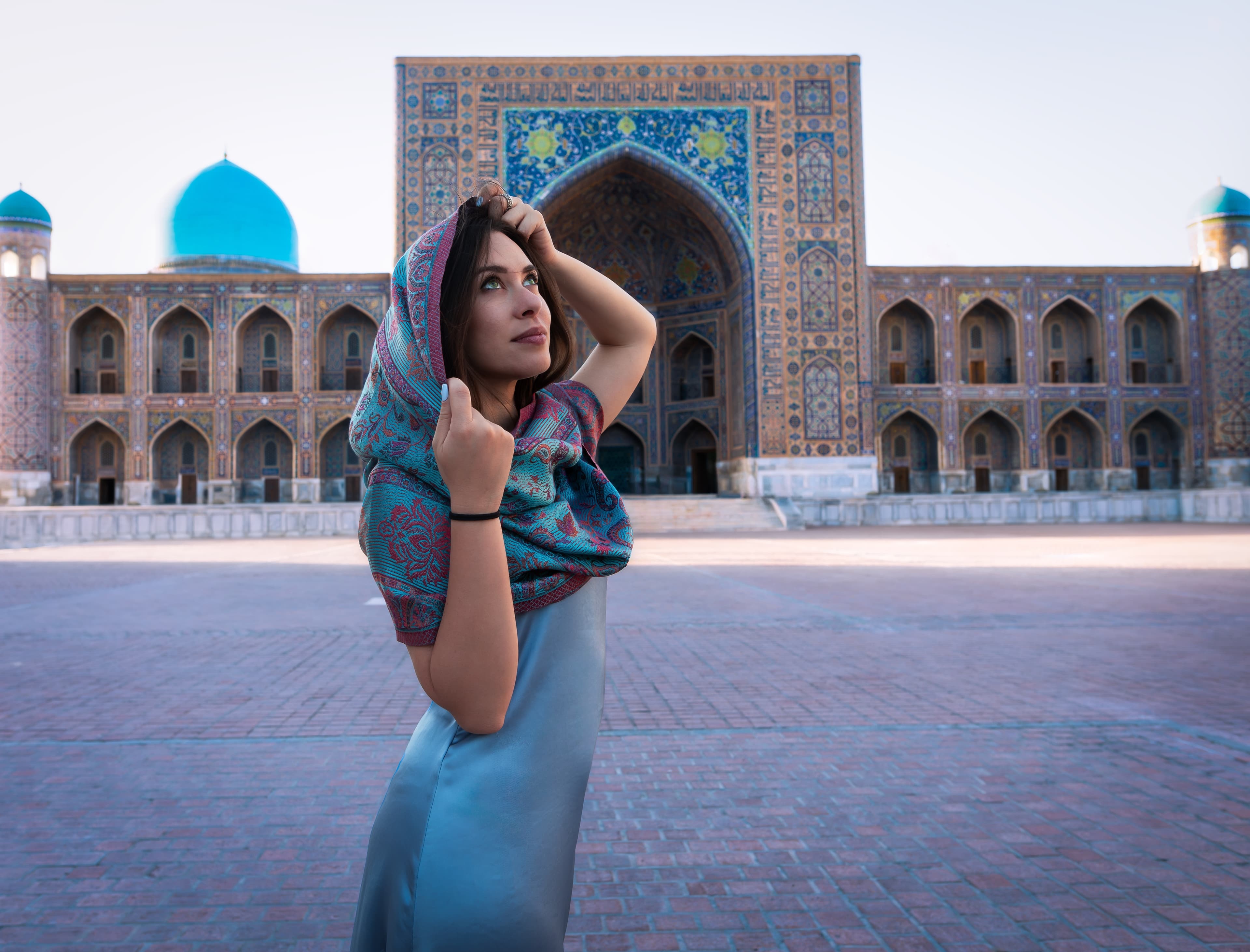.png_1920x1280%20(29).png&w=3840&q=75)
.png_1920x1280%20(31).png&w=3840&q=75)
.png_1920x1280%20(30).png&w=3840&q=75)
.png_1920x1280%20(29).png&w=3840&q=75)
.png_1920x1280%20(28).png&w=3840&q=75)
.png_1920x1280%20(29).png&w=3840&q=75)
Explore Bukhara’s highlights: Lyabi Hauz, Magoki Attori Mosque, Chor Minor, Kalyan Minaret & Mosque, Uzbek lunch, Mir-Arab & Ulugh Beg Madrasahs, Ark Fortress, and Bolo Hauz Mosque.
- Lyabi Hauz – Historic square with peaceful pool and surrounding madrasahs.
- Magoki Attori Mosque – One of Central Asia’s oldest mosques with unique sunken structure.
- Chor Minor Madrasah – Famous for its four distinctively decorated minarets.
- Kalyan Minaret – Iconic 12th-century tower and call-to-prayer landmark.
- Ark of Bukhara – Ancient royal fortress with palaces and museums.
Begin your tour at Lyabi Hauz, a lively historic square centered around a serene pool surrounded by ancient mulberry trees and flanked by beautiful madrasahs. Visit the Magoki Attori Mosque, one of Central Asia’s oldest mosques, built atop former Zoroastrian and Buddhist sites, famous for its partially sunken structure and intricate brickwork.
Explore the unique Chor Minor Madrasah, known for its four distinctively decorated minarets, symbolizing cultural diversity. Admire the soaring Kalyan Minaret, a 12th-century tower that once called faithful to prayer and served as a watchtower, followed by the nearby Kalyan Mosque, one of the largest and most magnificent in Central Asia with its vast courtyard and over 200 ornate wooden columns.
Enjoy a traditional lunch at an Uzbek national restaurant, tasting authentic dishes such as plov and shashlik. Afterward, visit the Mir-Arab Madrasah, an active Islamic school with stunning tilework, and the Ulugh Beg Madrasah, a 15th-century institution famous for its scholarly heritage.
Discover the massive Ark Fortress, an ancient royal citadel with palaces, mosques, and museums showcasing Bukhara’s royal and military history. Conclude your day at the charming Bolo Hauz Mosque, notable for its elegant wooden columns and painted ceiling beside a tranquil pond.
This tour offers a comprehensive experience of Bukhara’s architectural marvels, spiritual sites, and vibrant cultural traditions.
A bottle of water
Sunglasses
Head and Knees should be covered for women.
Hotel Pick-Up and Drop-Off
Professional Guide
Transportation between sites
All Taxes
Admission Tickets
Food and Drinks
Personal Expenses
Tips (Optional)
Lyabi Khaus
Lyabi Khauz is a historic square in the heart of Bukhara, centered around a peaceful pool surrounded by ancient mulberry trees. It’s flanked by beautiful madrasahs and a khanaka from the 16th–17th centuries. Today, it’s a lively social hub where locals and visitors relax, dine, and enjoy the atmosphere of old Bukhara.
Magoki Attori Mosque
Magoki Attori Mosque is one of the oldest mosques in Bukhara, originally built in the 9th century over a former Zoroastrian temple. Its partially sunken structure and intricately carved brickwork reflect layers of Bukhara’s ancient religious and architectural history. Today, it also houses a small carpet museum, offering both cultural and historical insight.
Chor Minor Madrasah
Chor Minor Madrasah, meaning “Four Minarets,” is a unique 19th-century structure in Bukhara, built by a wealthy merchant. Unlike traditional madrasahs, it features four distinctive towers with different decorative motifs, symbolizing diversity in Islamic culture. Though small, its unusual design makes it one of Bukhara’s most photographed and charming landmarks.
Kalyan Minaret
Kalyan Minaret, also known as the "Tower of Death," is one of Bukhara’s most iconic landmarks, built in 1127. Standing 47 meters tall, it once served as a call to prayer and a watchtower. Its elegant brickwork and towering presence dominate the historic Poi Kalyan complex.
Kalyan Mosque
Kalyan Mosque is one of the largest mosques in Central Asia, built in the 16th century as part of the Poi Kalyan complex in Bukhara. It features a vast courtyard, a majestic blue dome, and over 200 intricately designed columns. The mosque remains a symbol of Bukhara’s religious and architectural heritage.
Lunch at Uzbek national restaurant
Enjoy a traditional Uzbek lunch at a national restaurant, where you’ll taste iconic dishes like plov, shashlik, and freshly baked non (bread). Surrounded by local décor and warm hospitality, the setting offers an authentic experience of Uzbek culinary culture. It’s a perfect break to savor the rich flavors of Central Asia.
Mir-Arab Madrasah
Mir Arab Madrasah is a stunning 16th-century Islamic school located in Bukhara’s historic center. Renowned for its grand facade and beautifully detailed tilework, it remains an active religious and educational site. The madrasah exemplifies Timurid architecture and has inspired many other buildings across Central Asia.
Ulugh Begh Madrasah
Ulugh Beg Madrasah in Bukhara, built in the 15th century, is a historic Islamic school known for its elegant blue-tiled facade and scholarly heritage. It played a key role in education and religious studies during the Timurid era and remains a striking architectural landmark in the city.
Ark of Bukhara
Ark of Bukhara is a massive ancient fortress that served as the royal residence and military stronghold for centuries. Located at the heart of Bukhara, it features palaces, mosques, and government buildings, showcasing layers of history from the 5th century onward. The Ark offers a fascinating glimpse into the city’s political and cultural past.
Bolo Hauz Mosque
Bolo Hauz Mosque in Bukhara is famous for its elegant wooden columns and beautiful painted ceiling. Built in the early 18th century, it sits beside a tranquil pool (“hauz”) and served as the royal prayer mosque for the emirs. Its charming architecture blends simplicity with intricate artistry.
Samanids Mausoleum
Samanids Mausoleum in Bukhara is one of the oldest and most exquisite examples of early Islamic architecture in Central Asia. Built in the 9th–10th centuries as the tomb of the Samanid dynasty founders, it features intricate brickwork patterns and a harmonious, symmetrical design. The mausoleum is celebrated for its historical significance and architectural beauty.
.jpg_topkapi_palace_guided_tour%20(9).jpg&w=3840&q=75)





.png_1920x1280%20(17).png&w=3840&q=75)